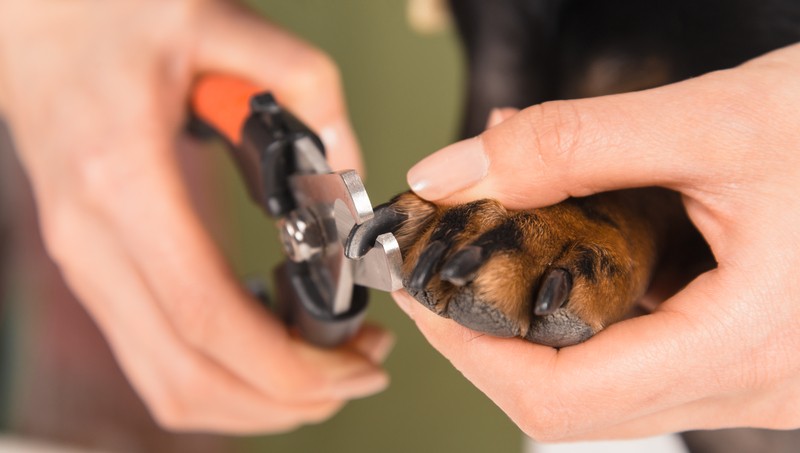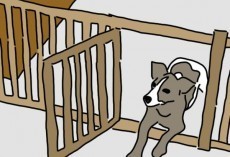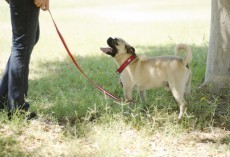If Fido is resisting getting her nails trimmed, first you will need to desensitize her fear and hesitation, which may take time. Don't give up if she continues to be afraid, but follow the steps below. Or, if you still find she's running away from you and experiencing intense anxiety around nail clippers, hire a doggy specialist to help.
Trimming nails is an important part of routine care for your dog. Although not all dogs need their nails trimmed because they wear them down naturally, almost all dogs need their dewclaws trimmed. Some dogs are reluctant to have their feet touched at all, while other dogs seem comfortable with touching but not with nail trimming.
Your dog may suffer from a more generalized fear of handling, which includes a fear of having his feet touched. If this is the case, you might need to resolve your dog’s anxiety related to other kinds of touching.
General Precautions
Avoid Cutting the Quick…
Dogs often develop a fear of nail trimming after they’ve had a painful experience—like getting a nail cut too short. The goal is to trim off only the dead end of the nail, but it’s sometimes hard to tell where the dead part ends and the sensitive live part begins.Treatment Exercises
The treatments used for fear of nail trimming are desensitization combined with counterconditioning. Don’t hesitate to contact an animal behavior.While you work with your dog to resolve his fear of nail trimming, don’t actually clip his nails. Instead, walk him on pavement during your treatment so that his nails wear down naturally instead.
Step One: Teach Your Dog to Like the Clippers
Dogs who fear nail trimming quickly learn to fear even the sight of nail clippers. So the first thing to do is teach your dog to be comfortable—and possibly even to enjoy—seeing you pick up the clippers.1. Sometime during the day, tell your dog something wonderful is going to happen. Get very excited and rush to the place where you keep the clippers.
2. Pick the clippers up and immediately give your dog a tasty treat, such as a bite of cheese or chicken, or toss him his favorite toy. Then put the clippers back in their place where your dog can’t see them.
3. Repeat the sequence of picking the clippers up, giving your dog a fabulous reward, and then putting the clippers away 5 to 10 times a day for one to two weeks.Step Two: Get Your Dog Used to Your Handling His Feet
Once your dog is comfortable with you picking up the clippers, you’re ready for the next step. Spend a few minutes every day gently touching your dog’s feet. Aim to do this one to five times a day.1. Sit down somewhere comfortable with your dog. During the exercise, talk to him in a soft, conversational tone and stroke him gently.
2. Briefly touch your dog’s whole paw and then immediately give him a tasty treat. Repeat this sequence a few times with each paw.
3. Touch just one of your dog’s toes and, again, feed your dog a tasty treat right afterwards. Then repeat, touching each of your dog’s toes on both paws and following each touch with a tasty treat.
You want him to accept having his paw touched first and then get rewarded with a treat.
Step Three: Adding the Clippers to Your HandlingExercises
Once your dog seems comfortable with you picking up and holding the nail clippers and with you touching his toes, combine these two exercises.
1. Go pick up the clippers, set them down on a table or the floor and touch each of your dog’s toes with your hand, following each touch with a treat.
2. The next step is to add the clippers to the paw-touching routine.
3. Now start to move the clippers in the direction of your dog’s paw. Do not touch his nails with the clippers yet. Just move the clippers a few inches toward your dog’s paw, put them down again and give your dog a treat. Wait a few seconds and then repeat the sequence.
4. The next step is to position the clippers on one of your dog’s nails, as if you’re going to clip it. This is a big step for your dog. He’ll probably get a little nervous and pull his paw away. Just do as you’ve done before: release your dog’s paw but don’t give him a treat.
5. Once your dog accepts you holding the clippers to his nails, quickly and carefully clip one. If possible, do this while your dog is lying in his bed, just waking up from a sleep so he’s still a bit groggy. Clip one nail only.
6. If all goes well and your dog hasn’t become uncomfortable again, clip a second nail the next day. If your dog does seem uncomfortable or concerned, take a few more days to touch and “air trim” before you try trimming another nail.• Do not manhandle your dog. Try to use as little restraint as possible during nail trimming.
• Do not scold your dog or try to intimidate him. If you do, it will be more difficult to trim his nails in the future.
• Take care not to let your dog’s toes twist as you clip his nails. The twisting alone can cause discomfort and scare some dogs, even if you’re carefully avoiding the quick.
Another important thing to note (that's also covered on ASPCA,) is if your Pug's nails are black you need to be extra careful when trimming her nails.
It will be difficult seeing where the quick is and the last thing you want to do is cause her nails to bleed. After she's okay with you trimming her nails don't cut a lot off. Work on a small part of the nail tips to begin with and stay calm while trimming her nails. Soon enough you'll both be pros.











Sheri Hessler
- Edit
Monty hates having his feet touched, but he doesn’t mind a quick clip. I also use a file on them as well. they get pretty ground down on walks as well.
Teresa Lohr Vitz
- Edit
Brien Vitz
Chris Reyes
- Edit
Lana Reyes
Shane Otto
- Edit
i dont blame him… its the TEETh bruching we’re in war with.
Sara Anderson
- Edit
He is my family and that means very much taken care of shots grooming and spoil!
Ken Haley
- Edit
Shannon Boyer Haley
Brian Grimes
- Edit
Rita Grimes Robert Grimes
J.c. Lake
- Edit
Kristy Berg Lake
Pamela Oprea Yenglin
- Edit
Every dachshund I had had hates nail trims and so my son will hold them and I would trim but it was a hassle every time, and we got nipped a few times too!
Donna Dunagan Hudgins
- Edit
My daisy will not let anyone trim her toes !! It’s a night mare .
Aimee Butler
- Edit
My willow hates to have her nails clipped too..she’s just a puppy & still has the sharp claws…its hard to get her to stay still even with help..she also hates it when I trim her paw hair to..I have nicknamed her fuzzypaws hehe